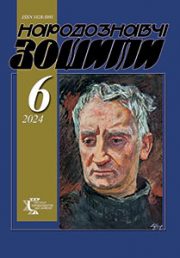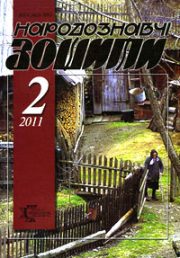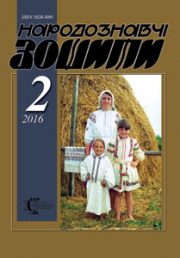The Ethnology Notebooks. 2024. № 2 (176), 261—273
UDK [39:631.51](477.86-12)”19/20″
DOI https://doi.org/10.15407/nz2024.02.261
TRADITIONS OF SOIL CULTIVATION IN THE ETHNOGRAPHIC POKUTTIA
PAVLYUK Stepan
- ORCID ID: http://orcid.org/0000-0003-0975-8099
- Doctor of Historical Sciences, Professor,
- Academician of NAS of Ukraine, Institute of Ethnology,
- The National Academy of Sciences of Ukraine (NASU),
- 15, Svobody Avenue, 79000, Lviv, Ukraine,
- Contacts: e-mail: ina@mail.lviv.ua
Abstract. The purpose of the article is to reproduce the traditions of soil cultivation in the ethnographic Pokuttia: to outline the systems of land preparation for grain
growing, to indicate agricultural tools, types of soil fertilization, etc. Land preparation systems for grain growing include fallowing on forestless areas.
In the 19th and 20th centuries the felling and cutting system had an exclusively episodic character. Life practice suggested to the farmer the efficiency of
using the arable field — maintaining soil fertility by alternating grain or root crops, as well as resting the soil.
Emphasis is placed on the types of soil fertilization — stable manure (obtained when using stationary, special stables for cattle and horses — premises for
cattle, and in some places and only in wealthy peasants — stables for horses); by means of prioritization of appropriate herbs that successfully restored the soil
structure — clover, wormwood, timothy, etc.; grazing, i. e. grazing on stationary fenced pastures for both sheep and cattle.
The object of research is national Ukrainian traditions of soil cultivation, and the subject of research is soil cultivation in ethnographic Pokuttia. The
geographical boundaries of the study are the ethnographic Pokuttia, and the chronological boundaries of the study are the 20th century inclusive.
The author concludes that the cultivation of edible fruits in Pokuttia was one of the main occupations of the local population, in contrast to the Hutsul Region,
where agriculture was mainly focused on rearing cows, sheep, less goats, horses, and poultry.
The Pokuttia landscape, fertile river valley soils, and a moderate climate contributed to the successful practice of agricultural production.
The methodology is based on general scientific methodological principles and the main requirements for works of historical and ethnological direction.
Keywords: soil, farming systems, soil fertilization, soil cultivation, relief, climate, traction force.
Received 27.03.2024
REFERENCES
- Zastavnyi, Yu. (1994). Geography of Ukraine. Lviv [in Ukrainian].
- Pavlyuk, S.P. (1986). Folk agricultural machinery of the Carpathian Ukrainians of the second half of the 19th and early 20th centuries. Kyiv [in Ukrainian].
- Pavlyuk, S.P. (1994). Folk agricultural machinery. Pokuttia. Kyiv [in Ukrainian].
- Zubrytskyi, M. (1906). The village of Mshanets, Starosambir district. Notes of NTSH (Vol. 70, p. 120). Lviv [in Ukrainian].
- Pavlyuk, S.P. (1991). Traditional farming of Ukraine: agrotechnical aspect. Kyiv [in Ukrainian].
- Dovzhenyuk, V.Y. (1961). Agriculture of Ancient Russia. Kyiv [in Ukrainian].
- Kolberg, Oscar. (1882). Рokuttia. Ethnographic images (Vol. 1). Krakow [in Polish].
- Horlenko, V.F., Boyko, I.D., & Kulchytskyi, O.S. (1974). Folk agricultural machinery of Ukrainians [in Ukrainian].
- Mandybura, M.D., & Pavlyuk, S.P. (1983). Boykivshchyna. Kyiv [in Ukrainian].
- Gorlenko, V.F. (1994). Agriculture. Tools. Podillia. Kyiv [in Ukrainian].






